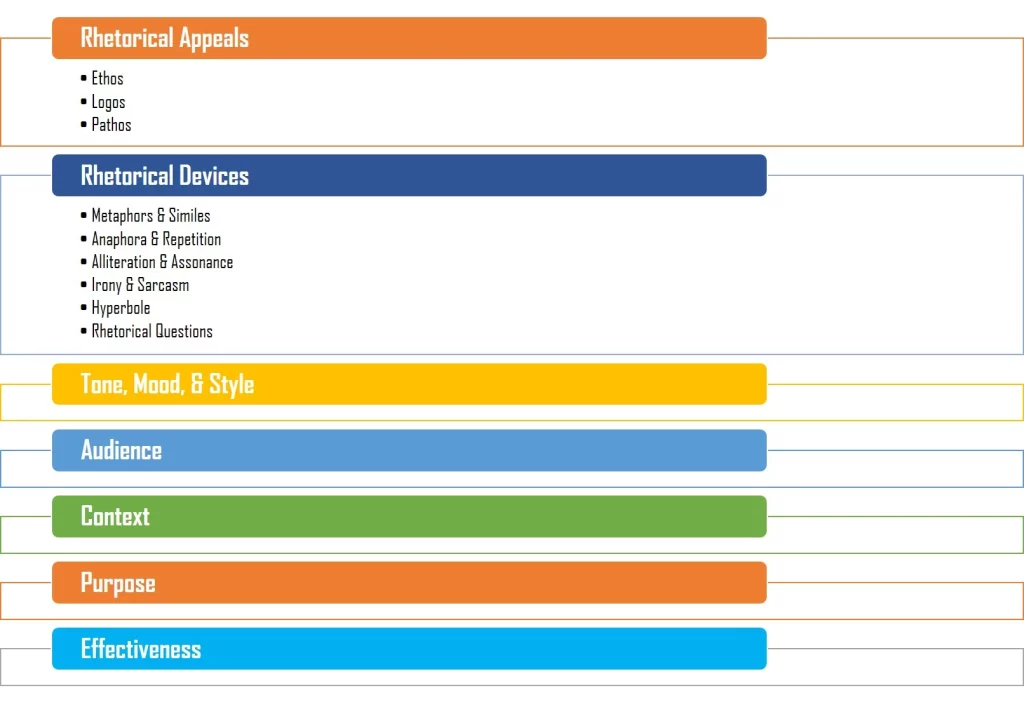
A speech rhetorical analysis is a process of examining a spoken or written communication, such as a speech, essay, or any other form of discourse, to understand and evaluate how the author or speaker uses rhetorical devices and techniques to convey their message, persuade the audience, and achieve their intended goals. Rhetorical analysis involves breaking down the speech into its constituent parts and analyzing how each element contributes to the overall effectiveness of the communication.
Key Components & How to Write
- Identification of Rhetorical Appeals: Rhetorical analysis typically begins by identifying the three main rhetorical appeals:
- Examination of Rhetorical Devices: Analyze the use of various rhetorical devices, such as:
- Structure and Organization: Evaluate the organization of the speech, including the introduction, body, and conclusion. Analyze how the speaker introduces and develops their main points.
- Tone and Style: Consider the tone of the speech (e.g., formal, informal, passionate) and the style of language used (e.g., figurative, technical).
- Audience Analysis: Assess how the speaker tailors their message to the intended audience. Consider how the speaker addresses the needs, values, and expectations of the audience.
- Context and Purpose: Examine the context in which the speech was delivered and the speaker’s purpose. What motivated the speaker to give the speech, and how does this influence their rhetorical choices?
- Effectiveness: Evaluate how effectively the speaker achieves their goals. Does the speech persuade, inform, entertain, or motivate the audience as intended?
- Conclusion and Overall Impact: Summarize your analysis and discuss the overall impact of the speech. How successful was the speaker in communicating their message and connecting with the audience?
Rhetorical analysis is commonly used in academic settings to study speeches, essays, and other forms of communication. It helps individuals gain a deeper understanding of how persuasive techniques are employed to influence an audience and allows for a critical assessment of the effectiveness of those techniques in achieving the speaker’s objectives.
Dos and Don’ts
- Analysis Supported by Evidence; Avoid Personal Bias:In a speech rhetorical analysis, it is imperative to base your analysis on concrete evidence from the speech itself. Avoid relying on personal bias or preconceived notions about the speaker or topic. Instead:
- Focus on Audience and Context; Avoid a Superficial Analysis:Understanding the audience and context in which the speech was delivered is crucial for a meaningful analysis. Avoid superficial assessments by:
- Evaluate the Big Picture; Avoid a Narrow Perspective:A robust analysis goes beyond isolated elements and considers the holistic message of the speech. Avoid a narrow perspective by:
- Critique Its Effectiveness; Avoid Overgeneralization:Assessing the speech’s effectiveness is a central part of rhetorical analysis. However, avoid making sweeping judgments without providing a nuanced evaluation:
In essence, a well-executed speech rhetorical analysis is marked by its reliance on evidence from the speech, its consideration of the audience and context, its holistic view of the message, and its balanced evaluation of effectiveness. By avoiding personal bias, superficial analysis, narrow perspectives, and overgeneralization, you can provide a more thorough and valuable analysis of the speech in question.
Examples
- “I Have a Dream” by Martin Luther King Jr.
- “Inaugural Address” by John F. Kennedy
- “The Gettysburg Address” by Abraham Lincoln
- “A More Perfect Union” by Barack Obama
- “Women’s Rights Are Human Rights” by Hillary Clinton
- “Commencement Address at Stanford University” by Steve Jobs
- “A Talk to Teachers” by James Baldwin
- “Blood, Toil, Tears, and Sweat” by Winston Churchill
- “The Ballot or the Bullet” by Malcolm X
- “First Inaugural Address” by Franklin D. Roosevelt
